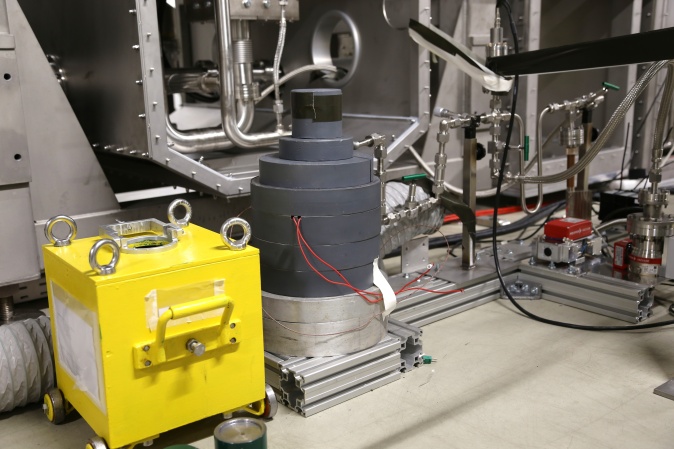
Successful tests of the neutrino project KATRIN with electrons from radioactive source
03. 08. 2017
The 70 m long complex apparatus of the KATRIN project, intended to measure the mass of the most abundant particle of the Universe - the neutrino, is almost completed in the Karlsruhe Institute of Technology (KIT). Its first tests were covered also in the NPI News on 27. 10. 2016. Complex tests of the KATRIN set-up with monoenergetic electrons from the sources developed in NPI were carried out in July 2017.
We have designed and tested two kinds of monoenergetic electron sources based on the radioactive decays of rubidium and krypton isotopes: 83Rb → 83mKr → 83Kr. We have improved the 83Rb production with the NPI cyclotron including radiochemical procedures for both types of the sources and carried out numerous physical investigations to find variants optimal for KATRIN needs. We aimed at shortening the cyclotron irradiation time, the highest possible purity of radiochemical procedures, extreme time stability of the energy of electrons emitted from the sources, and high efficiency of the electron emission or 83mKr emanation. An imperative requirement was to avoid contamination of the KATRIN set-up with 83Rb with 3 months half-life.
The first type of the sources is prepared by implantation of 83Rb into a conducting backing in collaboration with the mass separator group of the University at Bonn. The sources are utilized in a monitor spectrometer watching the stability of the KATRIN analyzing voltage on a metrological level - of a few parts per million of the nominal value per month.
The second type of the sources can be obtained by a deposition of 83Rb into zeolite beads (a molecular sieve). We have developed a generator enabling deposition of the 83Rb with activity up to 1 GBq. Produced gaseous 83mKr can be introduced into a KATRIN tritium source in a controlled manner. The monoenergetic electrons emitted in the 83mKr decay are suitable for tests, calibration and systematic investigation of the tritium source. The described zeolite source also provides a necessary input for the apparatus “83mKr condensed source” that was developed for KATRIN by the physicists of the University at Münster.
During the recent tests, for the period of 16 days, the nearly whole KATRIN system including the monitoring spectrometer was operated continuously. Only the “Rear Section” and “Tritium Loops” were not included. Both types of our sources were successfully applied, the zeolite source both for filling whole volume of the future tritium source as well as for a system of the condensed 83mKr source. Analysis of almost 600 electron spectra gathered during the tests will provide valuable information needed for a reliable long-term measurement of tritium beta-spectra.
The start of commissioning of the tritium source including the loops is expected in January 2018. The tests will be performed with gaseous deuterium complemented with 83mKr from our generator. The first runs with a small tritium activity are scheduled on May 2017.

Our 83Rb → 83mKr → 83Kr generator in the tritium laboratory of the KIT during complex tests of the KATRIN set-up in July 2017. The container for transport of the zeolite source from the NPI to KIT is shown in the left part of the figure.
Read also
- The Nuclear Physics Institute of the CAS celebrated its 70th anniversary
- The NPI stand at VědaFest broadcast live on Czech Television
- Second “Day with Theoretical Nuclear Physics” attracted students from across the country
- Martin Schäfer receives Otto Wichterle Award
- NPI organized the ReMade@ARI workshop, focusing on cutting-edge materials characterization and international collaboration
- NPI Co-Organized the 5th Meeting of the EIC International Financial Committee at BNL
- Radiocarbon Dating Reveals Gaps in Elephant Protection
- We are participating in two new projects focused on cosmic rays
- Roman Garba presented his research in Austria and the United Kingdom
- Our Research on Improving Silver Content Measurement in Mushrooms Supported by the AV21 Strategy

